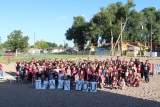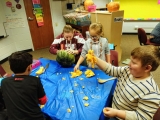-
Category 1
Selected in 2019
-
Grades: k - 6
School Setting: rural
Town Population: 596
Student Enrollment: 165
Student Demographics:
Black/African American: 0.6%
Teacher/Student Ratio: 1:12
White/Caucasian: 72.4%
Hispanic: 25%
Hawaiian/Pacific Islander: 0%
Asian: 2%
Native American: 0%
Other: 0%
% Reduced Lunch: 40%
% ELL Learners: 0%
Founded: 1921 -
PRINCIPAL:
Lauren Votruba -
CONTACT:
610 Columbia Ave, PO Box 487, Swink School District
Swink, CO 81077
719-384-8103
lauren.votruba@swink.k12.co.us
Swink Elementary School
Swink, CO
We prided ourselves on high academic achievement.
- Describe specific programs in place to ensure that families are involved in the success of your school and students.
- In order for school improvement or growth, celebration is vital. Quarterly we have an Awards Assembly which honors students academic achievement but also character and attendance. Parents and community members fill the bleachers to participate in these assemblies. Communication with parents is another key to success. Parents receive texts, emails, and papers informing them of events at the school, what their child is learning during the day, and specific information on the Second Step curriculum taught in all grades. We also utilize social media, our school website, and school media presentations. Students are engaged academically through our student system where they can check grades and attendance.
- Describe the most successful activity your school has initiated to strengthen ties to your community.
- Our community is very supportive of Swink School and we have continued to strengthen those ties in many different areas. Our parent outreach nights have increased our community involvement. Our school has hosted several guest speakers about relevant topics, Colorado Night, Cooking Club, and several musical concerts. Parents and community members feel welcomed, valued, and appreciated.
- Describe your philosophy of school change or improvement.
- School change or improvement does not happen overnight, it doesn’t happen instantaneously like a polaroid picture, but rather takes time to develop. It starts with understanding that every student is able to succeed. Success might look different for each child, but every single student is capable of it. School change starts from the ground up. It is much more effective if teachers and students are provided tools and resources that help change and makes improvements than to have the head of the district come in and require a new set of laws, rules, policies, or regulations. Change occurs through the use of evidence-based best practices that are taught, modeled, and shared explicitly to teachers first, then to students, then to parents and the community. In order for change to happen, celebrations of the little accomplishments must happen. It is important to celebrate and then be able to look back and see the growth and change and improvement.
- What are your school’s top two goals for the next year?
- Swink School has prided ourselves on our high academic achievement. Through analyzing data and conversations with staff and community, student growth is our top goal for the upcoming school year. New challenges arise for students who are high achievers, but there seems to be a declining trend in the academic growth of our students over time. Data Driven Dialogues have occured to discuss possible reasons for the decline and to provide solutions to help measure that trend. Another goal for Swink is to provide more opportunities for students to experience diverse backgrounds and cultures. We have a variety of external resources that can help us meet this goal and enrich students’ lives by understanding and learning about the world outside of our small rural town.
- What is the single most important factor in the success of your school that others could replicate?
- Integration of social emotional academic development and teaching the whole child is something that every school has access and ability to do. Realizing that students have needs beyond academics that need to be addressed, supported, and recognized is vital. The Building Blocks for Learning help to demonstrate these tiers and skills students need to have mastered before being successful academically. With the ever-increasing list of resources to help with student mental health, staff can be provided resources to help students.
- Describe the program or initiative that has had the greatest positive effect on student achievement, including closing achievement or opportunity gaps, if applicable.
- Three years ago, Swink School started looking at Social Emotional Academic Development (SEAD). We believe that a child is more than their academic ability, and that each student has social and emotional needs as well. There is a hierarchy of needs and abilities that need to be met and mastered before even academics is successful. Our school started small and introduced mindfulness strategies, strategies to help build relationships, and built a committee to help students who struggle socially and emotionally. This team meets weekly to discuss options for students. Since the original implementation of SEAD, our district has incorporated LifeSkills training for all students, restorative practice circles have been implemented, teachers have been trained in the PDSA cycle and continuous improvement, and students work on individual and group goal setting.
- Identify the critical professional development activities you use to improve teaching and student learning.
- Our professional development programming is fluid and adapts to the needs of our staff. Training in understanding Social Emotional Academic Development provided staff tools and understanding that students have other needs that need to be met. The idea of the Whole School, Whole Community, Whole Child (WSCC) was shared with staff. Restorative practice circle training was also implemented and allowed staff another tool to build stronger relationships with students. Continuous improvement through the use of the PDSA cycle helped teachers with student and class goal setting, analyzing data, and adapting learning strategies to reach all learners. Additional training in student goal training and engagement provided staff more knowledge in the ability to help set goals and ensure students are engaged.
- Describe how data is used to improve student achievement and inform decision making.
- WIthout data schools and districts cannot measure if they are improving. Swink School uses data in a variety of ways to help make the best decisions for students. Data is used to drive instruction, provide extra support, and provide extension or more challenging instruction. Data is also used regularly in the classroom setting during the Plan, Do, Study, Act Process. Teachers are trained to look at data such as state assessments, local assessments, eligibility, and attendance, work with students, and come up with goals, both short-term and long-term. Throughout the year those goals are evaluated with data from the students. Students are familiar with their individual data and learn strategies and techniques to help them grow. When areas of weakness are found, data is collected and analyzed in order to evaluate a root cause to help create solutions.
- Describe your school culture and explain changes you’ve taken to improve it.
- Swink School culture has changed dramatically in the past three years. Visitors now say that Swink is inviting, people are smiling, and they feel like they belong which was not the case just a few years back. Teachers feel empowered to teach, make decisions, and take risks. Students are provided ample extracurricular opportunities, challenging academic coursework, and the support they need to be successful. Over the past three years we have incorporated the idea of Social Emotional Academic Development (SEAD) which focuses on the child as a whole, and meeting their needs in all areas, not just academically. Staff have received professional development about circles, which help to build relationships and trust in classrooms, student goal setting, continuous improvement and other social emotional strategies that are utilized. Teachers and students collaborate to make learning effective and efficient for all students, working through goal setting and Plan, Do, Study, Act (PDSA) cycles.
Stats
-
Category 1
Selected in 2019
-
Grades: k - 6
School Setting: rural
Town Population: 596
Student Enrollment: 165
Student Demographics:
Black/African American: 0.6%
Teacher/Student Ratio: 1:12
White/Caucasian: 72.4%
Hispanic: 25%
Hawaiian/Pacific Islander: 0%
Asian: 2%
Native American: 0%
Other: 0%
% Reduced Lunch: 40%
% ELL Learners: 0%
Founded: 1921 -
PRINCIPAL:
Lauren Votruba -
CONTACT:
610 Columbia Ave, PO Box 487, Swink School District
Swink, CO 81077
719-384-8103
lauren.votruba@swink.k12.co.us






